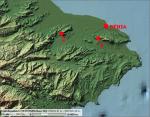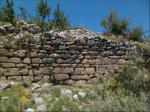Summary (English)
From 2001 to the present, within the research project El desarrollo de las guerras civiles romanas y la transformación del mundo indígena en el sureste de Hispania (HAR2009-11334), particular attention has been paid to the superficial recognition and topographical survey of the coastal sites of Alicante with a Republican chronology. In addition the ancient excavations from these sites as well as its most significant materials, placed in the Museo Arqueológico de Alicante, have been examined using present knowledge and methodology.
The Passet de Segària has traditionally been considered as a Late Iberian settlement; however, currently it is interpreted as a military fortress associated with the defense of the naval base of Sertorus during the civil wars or with some event shortly after.
This possible reinterpretation of the site has been made thanks to the analysis of building remains and militaria items found in clandestine excavations, as well as its strategic location in the southern end of the Gulf of Valencia. Its study until now was based only upon a succinct quote of E. Llobregat’s (1975), mentioning the finding of smooth Iberian pottery and common Roman pottery. In addition, an intervention directed by C. Aranegui and H. Bonet, took place in the seventies, which consisted of several corings at the foundations of the wall to perfect its dating but with no conclusive results. However, the intervention did reveal the strong construction of square ashlar, used to build the best preserved wall of the fortification.
This set of stretches of stone curtainwall is located on the sunny side of the Sierra de Segària, at its westernmost end and with an average height of 430 meters, dominating from this vantage point the whole flatland that lies at its feet around the Girona River. Despite its steep slopes, the location corresponds to a traditional transit point across the mountain –El Passet–, connecting this valley to the Pego and its marshland. For this reason and centuries after the Islamic settlement, a new defensive structure was built at the same place just 100 meters east from the remains now studied, to control this transit point.
It comprises a set of walls covering an area of nearly seven hectares, placed at different heights, sometimes even with various constructions, and reaching a lineal distance of 275 meters between its most extreme points. The site is considered significantly inaccessible and, doubtlessly, must have been a clear visual landmark during its occupation.
The visible remains are accompanied at all times by a notable superficial ceramic record, quite similar regarding types to that located in La Penya de l’Àguila. Due to the elaborate work of its defences at some points and due to the tendency revealed by the superficial remains to enclose a portion of the mountains entirely, this ensemble seems to be a fortress of significant size. Moreover, it offers arguments to support the stability and continuity of the military contingent that settled there.
(translation by Pilar Alarcón Blázquez)
- Jesús Moratalla Jávega, Feliciana Sala Sellés y Fernando Prados Martínez
Director
- Jesús Moratalla Jávega, Feliciana Sala Sellés y Fernando Prados Martínez (Universidad de Alicante)
Team
- Lorenzo Abad Casal, Carolina Doménech Belda, Julia Sarabia Bautista, Víctor Cañavate Castejón, Mercedes Tendero Porras, Ana Ronda Femenia y Sonia Bayo Fuentes
Research Body
- Colegio Oficial de Doctores y Licenciados en Filosofía y Letras y en Ciencias de Alicante - Sección de Arqueología
- Universidad de Alicante
Funding Body
- Universidad de Alicante






![Download [PDF]](/excavation/skins/fasti/images/results/download_sml.png)
